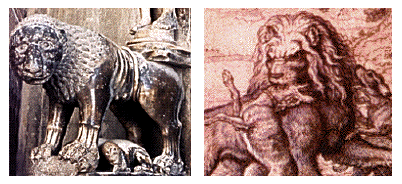From icon to image
In the same way that artists creating engravings for the new herbals observed and recorded plants with increasing accuracy, those who portrayed animals concentrated less on the iconographic* significance of the animal and more on creating a naturalistic image of it. Art stimulated--and learned from--biology. (More on the history of art in the Renaissance.)
The medieval sculptor had probably seen lions only in bestiaries*; the seventeenth century artist of the pen and ink drawing on the right captured both a more accurate image of a lion (lions were kept in the Tower of London) and the drama of the imagined encounter with attacking hounds. (Another painting of hounds on the attack.)
The Aberdeen Bestiary Project has some fine illustrations
Footnotes
-
Changing perceptions
Medieval writers were in general more interested in what a thing meant than in what it was. The Renaissance was thus a time of transition between perception that stressed the meaning of an object and one that sought to describe it objectively -- scientifically.
An anchor was not just an object to stop a ship from moving, nor an eel simply a long fish.
-
Examples for humans
Bestiaries were popular books of moral rather than zoological instruction. Various animals, real and mythical, were described, along with their behaviour (also real or mythical). The author then provided a moral lesson that could be learned from this behaviour. Thus, for example, the pelican was supposed to peck at its breast until it bled, so that the chicks could feed on its blood; this self-sacrif1ce was related to the action of Christ.
